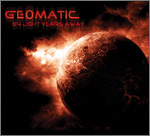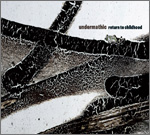It has been a busy and eclectic twelve months for Tympanik Audio with a good fifteen or so new albums under its belt since this time last year. Released in batches of between two and four albums at a time, the choice that is subsequently offered is no illusion and 2010’s roster displays a pleasingly diverse array of styles that fit nicely with Tympanik Audio’s Electronic music for the rest of us tag-line. This 3View article focuses on Geomatic’s 64 Light Years Away, SE’s L36 and Undermathic’s Return To Childhood.
 (Geomatic :: 64 Light Years Away) It should come as no surprise that an album with a name like ’64 Light Years Away’ and that sleeve artwork is a distinctly sci-fi tinged musical experience, even if the moniker Geomatic does sound like a brand of washing machine. This is the second futuristic album from Tympanik Audio this year, but where Candle Nine’s The Muse in the Machine was all about tension, mood and nostalgia, 64 Light Years Away seems to be all about location, environment and fast-paced action, what James Cameron’s Aliens was to Ridley Scott’s Alien you might say.
(Geomatic :: 64 Light Years Away) It should come as no surprise that an album with a name like ’64 Light Years Away’ and that sleeve artwork is a distinctly sci-fi tinged musical experience, even if the moniker Geomatic does sound like a brand of washing machine. This is the second futuristic album from Tympanik Audio this year, but where Candle Nine’s The Muse in the Machine was all about tension, mood and nostalgia, 64 Light Years Away seems to be all about location, environment and fast-paced action, what James Cameron’s Aliens was to Ridley Scott’s Alien you might say.
It has taken two prior albums for the Dutch-based outfit Geomatic to hone their skills to the level shown on 64 Light Years Away, the ambient expanses of their debut Control Agents having been patched into the more minimal, far-eastern chants and melodies of their second, Blue Beam, and then shot-through with high energy protons to create their most focused and intense work yet. This fusion of psytrance, sci-fi special effects and Muslimgauze-styled eastern percussion and instrumentation evoke the otherworldly desert settings of films like Stargate and Dune or the mysterious alien presences in the most atmospheric of computer games such as the original Homeworld, so much so that it could successfully play as the score to many of the great strategy game classics like Starcraft. This is not meant to imply that it lacks impact as a standalone experience, simply that it has definite pulse-pushing potential as score or soundtrack, being memorable yet easy enough on the ear that looped listened never gets boring or distracting.
If you’re still in any doubt, just listen to the album’s killer opening track “Nano Anu” that packs everything that’s great about 64 Light Years Away it into a frenetic and tightly-edited five minutes. Barrelling along at breakneck speed, thumping industrial bass drums pummel grimy synths and flashing atmospheric discharges in a dense and distorted whirl of mystical eastern strings, pipes and tabla. This vast soundstage remains as events slow down during “Aftab E Siyah” that describes a scorched and remote desert construction site, the clanging of metal on metal heard as glinting alien colossi are forged in the scalding heat and wind-swept white sands.
There’s extensive use of heavily vocodered and processed vocals here too, most notably as the album reaches a three-track fever pitch that begins with “Above Horizon.” The glitching voice of some malfunctioning alien cyborg belches and splutters over tumbling, broiling percussion, and is then used even more effectively on the lumbering “Serpent’s Tooth” in which every second is packed with sputtering hydraulics, electronic pulses and twisted breakbeats.
Ultimately it can’t all be like that; that would be exhausting, so the pacing is tempered by a number of dark ambient pieces, voyages through the darkness of space connecting one action-packed destination with another. It is with the help of these tracks that the galactic scale of 64 Light Years Away is fully realised with horns, pipes, vocal chants and calm chatter festooning tracks like “Sacrifice,” “White Hole, Dark Soul,” and the particularly evocative, crystalline formations of “The Fourth Plane.” There are moments where things spins a little too far out of control, such as on the incredibly unsubtle “Shesqi” or the rather dreary closing track “Final Dimensional Shift,” which is proof that in this genre it’s better to go out with a bang than a whimper, but they are few and far between.
With 64 Light Years Away, Geomatic have crafted a superbly paced, immaculately presented album that is simultaneously familiar, addictive, atmospheric and adrenaline-pumping and one that works in a multitude of contexts. This is easily one the best albums Tympanik Audio have released in a long time and one can only hope that with two stellar sci-fi releases in one year they will continue to embrace the genre in their ongoing campaign.
::..:::…..:..::….:::::..:::..:::::::……:::…::.:::….::::..:..:::…::…….:::::
 (SE :: L36) L36, SE’s second album for Tympanik Audio, is a genuine oddity especially given the glitchy and experimental nature of his debut, Epiphora. This isn’t immediately apparent as “Chrono” kicks things off with expansive and hefty bass drones underpinning a multiplied ticking clock and an unashamedly visual and melodic tension block, setting a moodily noirish tone. But then along comes “Stadium” and one can’t help wondering for a moment if a pressing error has occurred on the disk, as processed guitar strumming is placed centre-stage amongst traditional electronic beat-work, sounding for all the world like a U2 song. No, really. Sebastian Ehmke actually appears to be fusing stadium-rock sounds with traditional IDM electronics and processing on L36 which, quite frankly, leaves one wondering to whom this is supposed to appeal.
(SE :: L36) L36, SE’s second album for Tympanik Audio, is a genuine oddity especially given the glitchy and experimental nature of his debut, Epiphora. This isn’t immediately apparent as “Chrono” kicks things off with expansive and hefty bass drones underpinning a multiplied ticking clock and an unashamedly visual and melodic tension block, setting a moodily noirish tone. But then along comes “Stadium” and one can’t help wondering for a moment if a pressing error has occurred on the disk, as processed guitar strumming is placed centre-stage amongst traditional electronic beat-work, sounding for all the world like a U2 song. No, really. Sebastian Ehmke actually appears to be fusing stadium-rock sounds with traditional IDM electronics and processing on L36 which, quite frankly, leaves one wondering to whom this is supposed to appeal.
Post-rock electronic albums are nothing new, but the aptly and pointedly named “Stadium” simply doesn’t fall into that category. Skipping over it may leave one less predisposed to notice the rock elements of L36, but there’s still something unnervingly nice about many of the tracks (“Lily” and “Dendrit” in particular) that seems at odds with Tympanik Audio’s hardened industrial image. Fair play to SE and Tympanik for branching out like this, but it is still tracks that remain truer to traditional electronica that fare much better. Harold Budd-esque pads fall in silken layers across “Mimikry” and “Weit,” the former accompanied by smooth strings, the latter festooned with glitchy beatwork and coruscating keys. “Strom” does a much more convincing job of incorporating guitar-work into its central motifs, a delicate, echoing riff floating dreamily through another valley of reverberating bass, muted chimes and tremulous, distorted washes that more than any other track on the album evoke the run-down, brutalist landscapes depicted on the album cover.
Its crowning moment comes with the nuclear winds, mechanical rhythms and buzzing synths of the penultimate “F-Sand-036,” but ultimately, L36 comes across as a confused entity suffering from quite extraordinarily acute multiple personality disorder, its most extreme moments of genre-fusing coming across as rather doe-eyed and a little bit wet. One more thing: consistent with the stadium virtues L36 extols, it’s rather pointless listening to this album on headphones as the album needs to fill a much larger space around the listener, the vibrating bass felt as much as heard and the clean, bright synths given room to breath in order to deliver the optimum experience. [Listen | Purchase]
::..:::…..:..::….:::::..:::..:::::::……:::…::.:::….::::..:..:::…::…….:::::
 (Undermathic :: Return To Childhood) Undermathic’s debut album Return to Childhood came out way back in October 2009, long enough ago that the follow-up, 10:10pm, has just been released to coincide with the date 10/10/10. Accompanied by a press-release containing a panoply of gushing hyperbole it was clear that Return to Childhood was considered a flagship release for the label, an expectation that is validated both by the more expensive, glossy six-panel digipak packaging and subsequently by 10:10pms own press release that describes Return to Childhood as a sleeper debut. So what was it that caused this album to fly so quietly under the radar and fail to capture the audience Tympanik Audio hoped for?
(Undermathic :: Return To Childhood) Undermathic’s debut album Return to Childhood came out way back in October 2009, long enough ago that the follow-up, 10:10pm, has just been released to coincide with the date 10/10/10. Accompanied by a press-release containing a panoply of gushing hyperbole it was clear that Return to Childhood was considered a flagship release for the label, an expectation that is validated both by the more expensive, glossy six-panel digipak packaging and subsequently by 10:10pms own press release that describes Return to Childhood as a sleeper debut. So what was it that caused this album to fly so quietly under the radar and fail to capture the audience Tympanik Audio hoped for?
Maciej Paszkiewicz’s signature sound on his Undermathic project certainly seems to be keyed into everything the label stands for: densely layered, gritty, swirling masses of sound frequently eschewing traditional beats and percussion, all augmented by a smattering of heartfelt, melancholic acoustic piano. Some of these dense, looped industrial arrangements are reminiscent of Neuropolitique albums of old like Nomenclature or Are you now or have you ever been? with a verse-chorus-verse-chorus structure that you wouldn’t necessarily with the genre and therein lies one of the problems with Return to Childhood: some of the tracks simply lack a sense of progression.
By blasting the listener from the outset with such intense soundscapes rather than building up to them they can come across as a little repetitive, lacking any real payoff. “Independence” is an unforgiving opener and a good example of this style of track, repeatedly swinging between upbeat, crunchy and relentless melodic passages topped with twinkling piano and harsher, industrial growling sections. And yet there’s no denying Paszkiewicz’s unenviable mastery of infectious melody, sonic layering and osmotic atmospheres and textures. An incredibly palpable tension and pathos courses through “Keep Out No Entry” as layers of static, hiss and crackle accompany more bright piano and a memorably dramatic synth hook.
Perhaps it has something to do with the rather choppy middle section of Return to Childhood. For every “Keep Out No Entry” or “Entropy” there’s a track like “Lighthouse” that is so dark it feels like it’s on the wrong album, or an “Understanding” that applies the same pea-souper effects and looped structures as other more successful tracks but lacks the much needed melodic hook. Nor does album really need “Submissive Woman,” an unnecessarily noisy, squawking coda to the far superior and more restrained “Ttaggg,” but things get back on track when the immersive “Entropy” hits, a far less linear piece with a genuine, calm after the storm payoff in its closing few minutes. “People Pass Each Other” is another high point of the album, full of brain-addling, organic, bubbling keys, fuzzy rhythms and touching, plangent piano. There’s an abundance of nostalgia and warmth on later tracks such as “Everything Too Late” and the closing title track, which might have been better utilised up front to make the album more initially inviting, but it does at least go out on a high.
Return to Childhood is not an immediate work, in fact it’s a definitive example of an album that grows on you slowly. This might sound strange but if it hasn’t clicked for you before, try listening to it at a time when you normally wouldn’t listen to something as blistering as this, say, on your portable media player when you’re about to retire for the night, on a transatlantic red-eye flight, during a bout of flu or in any other kind of altered state, and then marvel as its murky, churning, defocused layers inject themselves into the bloodstream. A sleeper it may be, but few albums sum up the label as well as this and I highly recommend giving it as much of your time as you possibly can. [Listen | Purchase]
::..:::…..:..::….:::::..:::..:::::::……:::…::.:::….::::..:..:::…::…….:::::
All releases above are out now on Tympanik Audio.

























